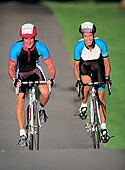
MONDAY, May 11, 2015 (HealthDay News) — Men who keep fit may find they delay normal age-related increases in blood cholesterol levels by up to 15 years, a new study suggests.
It is common for cholesterol levels to rise with age and then decrease later in life, the study authors explained in background notes. Previous studies have shown that high cholesterol levels can be a risk factor for heart disease. Regular physical activity can lower this risk, the researchers said.
“Exercise and being fit helps keep arteries clear by lowering ‘bad’ [LDL] cholesterol and boosting ‘good’ [HDL] cholesterol,” explained study author Dr. Xuemei Sui, an assistant professor at the Arnold School of Public Health at the University of South Carolina in Columbia, S.C.
“It also reduces other risk factors for atherosclerosis [narrowed arteries] and blood clots, such as high blood pressure, diabetes, obesity and stress,” Sui said.
The study was published online May 11 in the Journal of the American College of Cardiology.
For the study, Sui and colleagues used data from health examinations performed during the Aerobics Center Longitudinal Study at the Cooper Clinic in Dallas. The long-term study ran from 1970 to 2006, and included just over 11,400 men, aged 20 to 90. Each took an exercise test on a treadmill to determine their baseline aerobic fitness level.
Researchers measured total cholesterol, LDL cholesterol, triglycerides (another type of blood fat), HDL cholesterol and non-HDL cholesterol (the total cholesterol level minus the good HDL cholesterol) in study participants.
Men with lower-than-optimal aerobic fitness had a greater risk of developing high cholesterol in their early 30s, the investigators found, while men with higher levels of fitness did not see high cholesterol develop until their mid-40s.
Men with what would be considered low aerobic fitness reached abnormal HDL and non-HDL cholesterol levels around their early 20s and mid-30s, respectively, while those with higher fitness experienced normal levels for the entire duration of the study, the researchers said.
Aerobic exercise uses the large muscles of the body and brings oxygen to those muscles for use during exercise. Some examples of aerobic exercise include brisk walking, running, biking, swimming, hiking and playing team sports, such as basketball and soccer.
“Exercise is a vital component of achieving lifelong cardiovascular health,” said Dr. Gregg Fonarow, professor of cardiology at the University of California, Los Angeles. “Regular physical activity and maintaining physical fitness has been shown to be associated with a lower risk of [heart attack], stroke, and premature cardiovascular death,” he added.
The men in this study were considered “highly fit.” Is this achievable for the general population? Yes, said Sui.
“Highly fit in this study refers to an individual who meets the current physical activity guideline levels of 150 minutes a week of moderate activity or 75 minutes a week of vigorous activity,” Sui explained.
Sui said this amount of exercise can be achieved by engaging in aerobic activity for 30 minutes a day, five days a week.
In other words, the men in this study were not professional athletes or marathon runners.
For those not currently exercising, the recommendation is to start slowly and progressively work up to the current physical activity guidelines, experts suggest.
While this study included just men, Sui feels the results would also apply to women.
“I don’t believe the results would be much different for women,” said Sui. “Examining the age-related cardiovascular factors and identifying the modifiable factors in women are future projects.”
Because this study emphasizes the importance of exercise in prolonging health, Sui and colleagues concluded that health care providers should counsel patients on exercise for disease prevention.
“This study, along with our previous studies on glucose [blood sugar] and blood pressure, provide an important message for health care providers that improving cardiorespiratory fitness may delay the onset of high cholesterol, diabetes or high blood pressure,” Sui said. “Clinicians should consider counseling their patients to increase physical activity levels in order to improve fitness.”
Fonarow gives this idea a nod. “I fully agree with the statement that greater emphasis needs to be made on educating individuals of all ages on the importance of exercise. Clinicians should educate their patients on the benefits of fitness along with providing advice on fitness regimens and individualized goals.”
More information
The U.S. National Heart, Lung, and Blood Institute has more about a healthy heart.
Copyright © 2025 HealthDay. All rights reserved.

